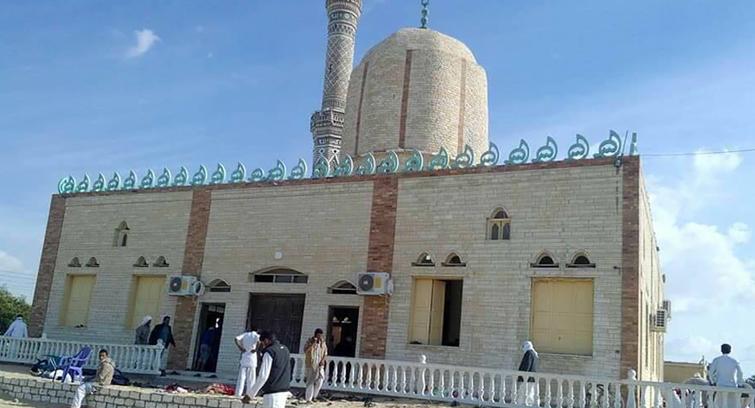Terrorism
305 dead, including 27 children, 128 left wounded: it’s the toll of the terrorist massacre of November 24th in the Al Rawdah Mosque, near the town of Bir al-Abd, in north Sinai. The attack signals a disquieting, radical change: Muslims gathered in prayer inside a mosque had never been attacked before. We addressed the issue with Michele Brignone, Scientific Secretary of the International Foundation “Oasis”, for whom, “after all these massacres the Muslim world has acknowledged the Jihadist threat, and certain connivances detected in the past are now starting to collapse”

The terror attack of November 24 in the Rawdah Mosque, near the town of Bir al-Abd, in Egypt’s northern Sinai region, left 305 dead, including 27 children, and 128 injured. A group of twenty gunmen arrived in four SUVs and opened fire on the faithful gathered in prayer. The terrorist fury raged against a Sufi place of worship, representing a branch of Islamic mysticism that the Islamic State brands as apostate and heretical. No group has claimed responsibility, yet suspicions fell on affiliates of the Islamic State. It was the first major attack on an Islamic congregation. All previous attacks were against law enforcement authorities and on the Christian minority population. We spoke about this massacre, numbering the highest death toll of the past years of terror, with Michele Brignone, Scientific Secretary of the International Foundation “Oasis”.
 Even in this case, the attack on the Al Rawdah Mosque appears to have been organized and devised against a minority group. Yesterday the Christians and now the Sufis. Did you identify new elements compared to similar incidents occurred in the past?
What I notice is
Even in this case, the attack on the Al Rawdah Mosque appears to have been organized and devised against a minority group. Yesterday the Christians and now the Sufis. Did you identify new elements compared to similar incidents occurred in the past?
What I notice is
a radical change: they attacked Egyptian Muslims gathered in prayer inside a mosque. The terrorists have carefully chosen their target.
It encompasses the most heinous aspects of Jihadist ideology, aimed at excommunicating not only non-Muslim groups and peoples but also Muslim congregations. In this case the Sufis were their target, in continuity with the aversion to Sufism, present in Salafist and Jihadist groups. Sufism is not a minority group. It represents millions of Muslims, and it’s a very significant dimension of Sunni Islam. Striking against Muslims gathered in prayer inside a mosque is a new mode of action that deserves special attention.
The Sinai region has been a target of terror attacks for years. Now it appears to have become a pivotal recruiting centre of the Caliphate … Inside the Egyptian State the Sinai is a marginal region, with few traits in common with the Nile Valley. The horizon of the peninsula is more directed towards Palestine and to the north-east, than towards Cairo. Historically, it was an area of conflict with Israel and since the year 2000 it has been the target of Jihadist terror attacks in the Red Sea, to which the then President Mubarak responded with harsh repression. The state of tension with the Egyptian Government, that broke out since then, has transformed the Sinai region into a recruiting centre of Egyptian and non-Egyptian jihadists, some of whom arrived from Gaza after Hamas seized power in 2006.

Could the fact that ISIS has not claimed responsibility for the massacre– given its usual promptness to do so in every attack –validate the hypothesis that the attack was intended as a warning to the Bedouin tribes in the area, increasingly less willing to cover up for the Jihadi militants in the peninsula and more inclined to cooperate with the central Government? It’s a possible interpretation of the facts. After 2013 Egypt’s strategy in the Sinai has changed by seeking greater cooperation with local tribes.
Thus the reasons underlying the attack could include the Jihadists’ intention to punish that part of the population that started cooperating with the State. As regards the fact that Isis has not claimed responsibility, we should consider the cruelty of the attack, that sends a clear message to Muslim populations. However, ISIS risks alienating the consensus it enjoys, however small.
The massacre is also a “political” message to the Egyptian government. What do they want to obtain? Rather than obtaining something they want to prevent the pacification of the Sinai region, which has been a thorn in the flesh of the central Government for years. Isis has every interest to maintain this chaotic situation. In the previous attacks their targets were the security forces. While now they attack harmless civilians. They want to show that Al Sisi is unable to guarantee the security of the area where Jihadist groups have free rein.
What should realistically be expected after the massacre? There could be an escalation motivated by a theoretical justification, namely that the Sufi are heretics who fail to practice true Islam, thereby expanding the enemies of Islam according to Jihadi ideology. However, it should be said that as a result of all these heinous attacks
the Muslim world has become aware of the Jihadi threat and certain connivances detected in the past appear to be collapsing.
Clearly, the opposition is not between the Islamic world and the Western world, but within Islam itself. And only Islam can defeat the Jihadist cancer.